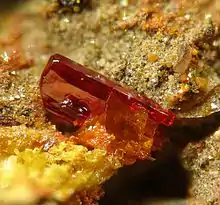Phoenicochroite
Phoenicochroite, also known as melanochroite, is a lead chromate mineral with formula Pb2OCrO4. It forms striking orange red crystals. It was first discovered in 1839 in Beryozovskoye deposit, Urals, Russia.[2] It is named from the Greek word φοίυικος for "deep red" and χρόα for "color," in allusion to its color.[2]
| Phoenicochroite | |
|---|---|
 Deep red Phoenicochroite cystal, with orange-yellow schwartzembergite. San Francisco Mine, Tocopilla Province, Chile. Photo width 1.5 mm. | |
| General | |
| Category | Sulfate (chromate) mineral |
| Formula (repeating unit) | Pb2O(CrO4) |
| IMA symbol | Phc[1] |
| Strunz classification | 7.FB.05 |
| Dana classification | 35.1.2.1 Anhydrous chromates |
| Crystal system | Monoclinic |
| Crystal class | Prismatic (2/m) (same H-M symbol) |
| Space group | C2/m |
| Unit cell | a = 14 Å, b = 5.67 Å, c = 7.13 Å; β = 115.22°; Z = 4 |
| Identification | |
| Color | Dark red, bright red |
| Crystal habit | Tabular crystals; thin coatings, and massive |
| Cleavage | Perfect on {201} |
| Tenacity | Sectile |
| Mohs scale hardness | 2+1⁄2 |
| Luster | Adamantine, resinous |
| Streak | Brick-red |
| Diaphaneity | Translucent |
| Specific gravity | 5.75,[2] 7.01[3] |
| Optical properties | Biaxial (+) |
| Refractive index | nα = 2.380, nβ = 2.440, nγ = 2.650 |
| Birefringence | 0.270 (δ) |
| 2V angle | 58° (measured) |
| Other characteristics | Health risks: contains carcinogenic and mutagenic chromate ion |
| References | [4][2][3][5] |
References
- Warr, L.N. (2021). "IMA–CNMNC approved mineral symbols". Mineralogical Magazine. 85 (3): 291–320. Bibcode:2021MinM...85..291W. doi:10.1180/mgm.2021.43. S2CID 235729616.
- Mindat.org Phoenicochroite on Mindat
- Phoenicochroite in the Handbook of Mineralogy
- Mineralienatlas
- Phoenicochroite data on Webmin
Wikimedia Commons has media related to Phoenicochroite.
This article is issued from Wikipedia. The text is licensed under Creative Commons - Attribution - Sharealike. Additional terms may apply for the media files.